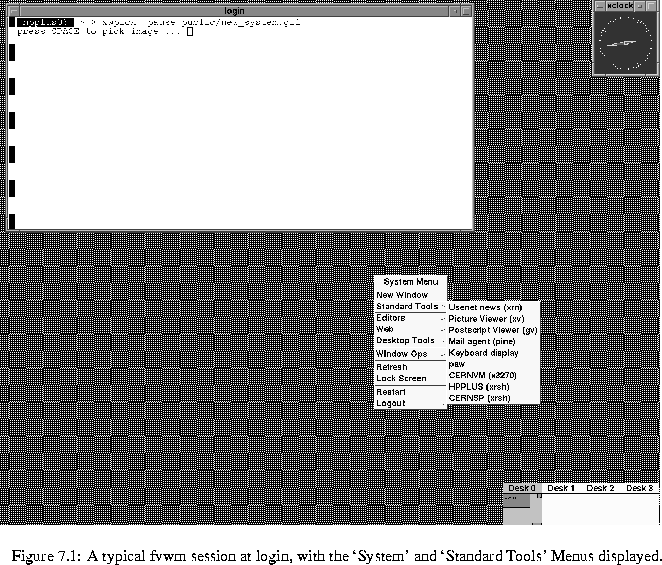
This website is no longer maintained. Its content may be obsolete. Please visit http://home.cern/ for current CERN information.
The default window manager with the HEPIX X11 scripts as used on the CERN central Unix platforms is fvwm:
fvwm is a powerful window manager which makes few demands on the operating system. At CERN, a very simple default configuration has been chosen. This default will be tuned over time to provide commonly desired features and menus. However, simple tailoring of the window manager is expected at the user and group level. For example, we have provided a hook for a `Group' menu to be found when the middle mouse button is clicked over the root window (`the backdrop'), and we already provide a `User' menu when the left mouse button is clicked in the root window.
This article gives brief introduction to fvwm. Space does not permit a description of how to customise it. A description of how to make simple customizations can be found here
There is also an expanded version of this article that describes simple customisations, available from the UCO (CERN/UCO/96/187).
Finally, some example files which will change the behaviour of your fvwm session from the default when copied (with the correct name) into your $HOME/.hepix/wm directory may be found here
More complex customisation is also possible (indeed we are not aware of any limitations on the customisation imposed by the HEPIX scheme); a guide to the full setup is provided here
Before any major customisation, we strongly recommend that you read the full fvwm documentation.
Such things as the client programs (such as clocks, desktop managers etc.) and root window (`backdrop') colours and patterns are not controlled by the window manager, but are controllable in the HEPIX X11 scheme. Indeed, other window managers can be requested, though they are not necessarily supported, and window managers that make a heavy demand on system resources are strongly discouraged on multi-user machines. Such things are not within the scope of this article, and you are referred to the relevant documentation.
When you begin a default HEPIX X11 session, you will be presented with a clock, an X-Terminal labelled `login' and a window in the bottom right-hand corner of the screen called the `pager'. This pager is subdivided into four areas labelled `Desk 0', `Desk 1' etc., each of which corresponds to a virtual desktop. By default, you start on Desk 0, and so you will see small representations of the login window, the clock and the pager in the `Desk 0' section of the pager. You can move to another virtual desktop by clicking with the left or middle mouse button in the appropriate area of the pager. Unless they have been declared `sticky' (which the clock and the pager have, by default), then your windows will not change desktop as you do. You can move windows between desktops by clicking with the middle mouse button on their representation in the pager, and dragging them to the representation of the desktop you want in the pager.
A `System' menu is defined which contains many of the commands you will commonly want to use. It may be obtained by clicking with the right mouse button while over the root menu (the `backdrop'). Some of the commands may be found in submenus (indicated by arrowhead symbols on the main menu; keeping the mouse-button depressed, just move down the menu to the submenu name to obtain the submenu. Currently, we provide submenus for editors, web browsers, standard tools, common window management tasks (such as making windows `sticky' or killing them) etc.
A `User' menu is provided by default; it is a copy of the System menu at the time that the user's account is created. This can be tailored by the user, as described below. A hook for a `Group' menu is also provided associated with the middle mouse button, but is left empty by default. Experiments and other groups should use this hook to provide common tools that their users might want.
Windows may be enlarged by clicking on the border with the left or middle mouse buttons and with the button still depressed dragging the window border to the desired size. Clicking on the border with the right mouse button produces a menu of commands that act on windows. Clicking and releasing on the window border or title bar `raises' the window above any others. The window may be brought into `focus' (which is jargon for `becomes the active window') merely by moving the cursor into the window area. Thus, you can type into a window while it is still partially obscured by another, which can often be useful. If you prefer to just click in the window to raise it and bring it into the focus, instructions for this customisation are given in the simple customisation document.
We have chosen fvwm as the default HEPIX window manager because it demands few system resources and provides the required user functionality. We have provided a system for user and group customisation within the HEPIX framework that ensures that the required order of commands is enforced in a transparent way. We have attempted to provide a default configuration that provides a good environment for the user. This will evolve with increasing experience and user feedback.